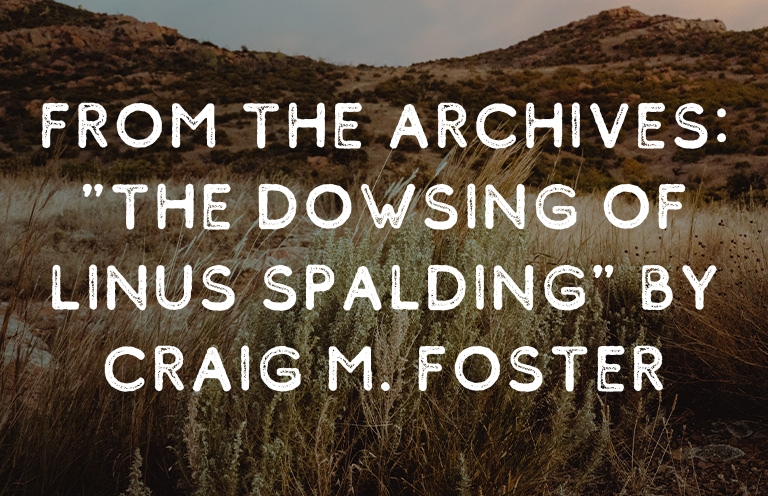I’m spoiler agnostic. By that I mean, I don’t generally care if the twist or ending of a story is told to me before I experience it. [This is most likely because my mother, deeply protective over her free time, delights in spoilers. She insists on hearing the plot summary of nearly every movie we watch before we begin. What if I won’t like it, she says. What if it’s a waste of our time? she asks. I can focus more on enjoying it if I don’t stress out about what’s going to happen, she insists. Dutifully, I read away.] Even though I don’t share her exact sentiments, to some regard, my feelings are similar. I don’t care if I walk into a story knowing what’s going to happen because the magic of a story—the real magic, the lasting magic—comes from how what happens, happens. There are many things that are special about Craig M. Foster’s “The Dowsing of Linus Spalding,” but this is one of the main ones. Because even though we hear “what happens” in this story at the end of the first paragraph—the creek that runs through the narrator’s property and through the story dries up, leaving her father a broken-down man without prospects—that doesn’t detract from the complexity, surprise, or enjoyment that comes from this piece.

Focus
Openings have a particular job to do. They need to set the stage for the coming piece—giving the who, what, and why of the piece, but they also need to set the tone of what’s to come. The opening paragraph of this story does its job effectively—introducing our first-person narrator, Ellie; her father; and the overarching issue of the water disappearing. However, the amount of the opening spent establishing those basic facts is comparatively small. More attention is spent on the setting, specifically the North Fork River and its offshoot Trace Creek. We even hear about how the Kiowa tribe was “hoodwinked and burglarized” of their land before we see the eponymous Linus Spalding. Striking this balance early is an effective and clever choice on Foster’s part.
The importance of the waterways to the lives of the surrounding residents is quietly established by this kind of focus. This is a story about people, but also about how people relate to the land on which they live. But additionally, the impermanence of an individual’s or community’s relationship to setting is brought to the forefront. Before we get into the actual meat of the plot, Foster primes us to look out for and be attentive to certain kinds of things in his story by how he sets up his opening.
Perspective
The choice of a first-person narrator in this story is very appropriate. The tension between rural and urban, between insider and outsider runs through this story. Linus’s wife is immediately distrustful of the professor who plants the idea of expanding their family farm in Linus’s head because he wears a tie. This story being told by a someone directly impacted as opposed to an impersonal omniscient narrator is important. But this could have easily been Linus’s story, about his foolhardy decision to expand his farm and how it negatively affected his family and his self-worth. However, Foster’s choice to have the story be told by his young daughter Ellie worked well here.
Child narrators can come with their own pitfalls. They often don’t have access to a lot of information or noteworthy experiences. Additionally, capturing the voice of a child can be tricky—six-year-olds and twelve-year-olds have different levels of maturity, vocabulary, and insight that can be hard to pin down as a writer but annoyingly easy to spot as a reader. Foster uses the child narrator to his advantage well here.
For example, after the Spalding family attends church, Ellie sees a confrontation between the professor and her father play out in the churchyard. We’re able to tell the nature of the conversation and the character dynamics at play based on the expressions and gestures of the character:
Then the professor started speaking right to Daddy. The preacher looked at his feet as the professor motioned strangely with both arms, moving them in a perpendicular line, as if tracing a river on the ground. He pointed at imaginary points along the river and looked somber as always. Daddy mindlessly scratched at his arm, eyes fixed on the professor, who continued his lecture for several minutes. The other men watched attentively.
The mounting tension of the scene is effectively and economically built by placing us on the outside. We can feel the “the anger without hearing the words” as Ellie later says. Ellie’s view outside of the adult conversation gives her and Foster the ability to seamlessly condense a much larger conflict down to its most salient and important elements without losing too much.
Furthermore, Ellie’s position in relationship to the broader events of the story helps reinforce the broader themes. The minutiae and mechanics of things like the co-op meeting where Linus got the idea and the meeting with the bank to get the loan are, of course, elements of this story, but not ones that Ellie would be privy to. Children, for better or worse, with limited agency, spend more of their time dealing with the fallout of decisions than making them themselves. Following Ellie highlights the helplessness that the whole family experiences. Having her narrate this story means that Foster and us as readers can focus more on the fallout without necessarily spending valuable page space on the set up.
Motifs and (opened) Gifts
I had a writing teacher, years and years ago, refer to under-explored or utilized elements in our writing as unopened gifts. He would, at the end of our drafts, write a little list of things that could have been expanded, explored, opened—so to speak—to make the story richer and more complex. Stories that utilize their motifs and recurring images well are generally a matter of quality over quantity. It’s not that these stories devote huge amounts of time or page real estate to these motifs, images, and metaphors—rather, they use them in strategically. Foster does an excellent job putting his motifs and imagery to work but also doing so economically.
A Cruel World
The frogs being gigged in the beginning of the story, of course, end up causing the loss of the Linus’s knife (which I’ll discuss in greater detail in a bit). But Ellie’s observation that the frogs seemed to be “practically hopping into our laps” not only gives us more detail on the Edenic plenty of their small farm, but also plants an interesting idea in the reader’s head: those frogs, destined to be cooked, jumping effectively to their deaths at the hands of a being they cannot fathom or understand. The connection of the knife to the buffalo who, after seeing one of their own dead, would circle up around it. “Then you could walk up right behind and kill them all real easy if you wanted.”
Ellie’s response to Linus’s story about his father’s experience hunting buffalo—“Doesn’t hardly seem fair to me”—expands upon the kernel of unease planted by the frog image. Ellie makes the next connection, of the Buffalo to WWI and “all our boys over there to get slaughtered”—more lives caught and destroyed a scenario that they couldn’t necessarily fathom or stop. WWI is not only the distant inciting incident for the story—the reason that more cotton is needed and thus why Linus thinks it would be a good idea to grow, the reason why water is diverted away from the creek and toward the mills in town—but it also serves as a thematic element that highlights something about the situation of the Spalding family stateside.
Even the wonder of the dynamite from the first half of the story becomes recast as something unsettling, gruesome even, when it vaporizes their new expensive plow horse after Linus fails to blow up the dam.
The Knife
One of the reasons why this story was so memorable for me was because of Linus’s knife. Ellie’s decision to not tell her father that she had found his lost knife was left wonderfully under-explained. It felt surprising and natural, but Foster gives the reader the space to put the elements together as to why we feel that way.
But Foster didn’t have to choose a knife for the object that Ellie searches for but doesn’t return—a locket or a watch could be an heirloom lost and found in the creek much like the knife. But I think that this image wonderfully links with the other images and motifs that he sets up throughout the piece.
The knife acted as a literalization of the connection between Linus and his father, the kind of connection that young Ellie desperately wants but cannot have. For Ellie, her desire to find it seems to not only be a desire to return a precious object to her father, but also to get access to her father’s head “a foreign place [she] always wanted to visit.” But again, this could have been a cross or a special coin and worked the same.
The knife’s connection to the killing of the buffalo, and the broader network of violent images that run through the story, also makes it a particularly interesting artifact for Ellie to search for. It served as a link back to the other instances of violence that run through the story—“a tower of buffalo, climbing up into a pyramid… the foreheads of boys peeking over the tops of trenches, getting sprayed with the same gunk or worse, and knew that they must vomit, too.” As I puzzled over the knife and the narrative weight it had accumulated, it changed how I thought about Linus’s actions. The knife made me think of the precarious situation that Ellie, her mother, and the unborn baby are placed in by forces outside of their control. Like the frogs, like the buffalo, like the horse, like the soldiers.
Again, Foster leaves this mostly unsaid, but he develops these related images enough so they work together and so the reader to make these connections themselves
In conclusion
A friend, looking to get into writing more seriously, once lamented that there were no good new stories to tell. That isn’t exactly right, but I can kind of see where they’re coming from. One year, working for a different literary magazine, I read more than two dozen stories about women steadily yet inexplicably becoming mermaids. But I feel that this worry about the lack of novelty misses the point, that the stories that stick with me after reading aren’t necessarily the ones that have a plot that no one has ever thought of before. The ones that stick with me are the ones that arrange their pieces in a way to spark something new in me as a reader.
by Melissa Bean
